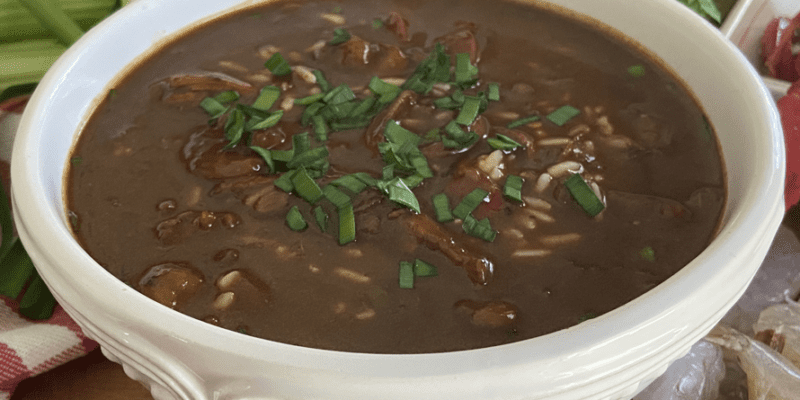Considered to be the official state cuisine of Louisiana, Gumbo is a popular soup throughout the U.S., though most aficionados would quickly dispute the moniker “soup.” It is so much more than that!
A brief history of Gumbo
Of all the dishes in the grand cookbook that is Louisiana cuisine, Gumbo is the most famous and, quite possibly, the most popular. It is often cited as an example of the melting-pot nature of Louisiana cooking, but trying to sort out its origin is speculative at best.
The name derives from a West African word for okra, “guingombo,” suggesting that Gumbo was originally made with okra. The use of filé, which is dried and ground sassafras leaves, was a contribution from local native tribes. And roux originates from French cuisine.
Dr. Carl A. Brasseaux of the University of Louisiana at Lafayette, author of the definitive history of the Cajuns, found that the first documented references to Gumbo appeared around the turn of the 19th century. In 1803, it was served at a gubernatorial reception in New Orleans, and in 1804 Gumbo was served at a Cajun gathering on the Acadian Coast.
What’s in it?
Though this question has almost as many answers as there are self-proclaimed experts, Gumbo is typically made with chicken or seafood stock, meat or shellfish, a thickener, what Louisianians refer to as the “Holy Trinity” of vegetables – onion, celery and bell pepper – and seasoning.
Most people are familiar with seafood Gumbo and chicken and sausage Gumbo, but almost any type of meat can be used. Many family recipes, handed down from one generation to the next, merely call for “whatever you shot that day,” or “anything you find in the icebox.”
Ingredients used to thicken Gumbo vary widely, as well. Okra is popular in many quarters, and filé is also common, though not as much as it once was. But the standard for most chefs is roux – flour that is browned in hot oil or animal fat.
It’s all about the roux!
Roux is typically made from equal parts of flour and fat. The flour is added to the melted fat or oil on the stove top, whisked until smooth, and cooked to the desired level of brownness. Butter, vegetable oil, bacon drippings and lard are commonly used fats, but in Cajun cuisine, vegetable oil and bacon fat are the most common choices.
As the flour cooks, it browns; the longer it cooks, the darker it gets. Light brown roux is thicker, but a dark brown roux has more richness and flavor. When it comes to Gumbo, many chefs agree that the darker the roux, the better. But there’s a fine line between dark brown and burnt. And once a roux is burned, the only solution is to start over.
Where can I get Gumbo?
Gumbo is on the menu at many seafood restaurants, particularly in the southeast U.S. Such eateries as Commander’s Palace and Arnaud’s in New Orleans, Brennan’s and Goode Co. Seafood in Houston, Hambone in Mandeville, LA, and Little Daddy’s Gumbo Bar in League City, TX have become widely regarded, boasting huge throngs of loyal followers.
But like anything else, personal taste will dictate your own favorite. And with the plethora of choices available, never forget the old adage, “Life is too short to eat bad Gumbo.” How will I know if it’s bad? you might ask. You’ll know!
Gumbo, Gumbo base, Gumbo mix, and Gumbo seasoning have become common place on the shelves of your local grocer in recent years as more and more people develop a taste for the Cajun delicacy. Grocery and specialty stores are looking to provide products people want, and that includes low sodium varieties, and even a gluten free Gumbo mix for those who love Gumbo, but are looking to eat healthier.
Summing things up:
Gumbo has been around a long time; it’s been on menus, in cookbooks, and served to dignitaries for well over 200 years. But just because you may have eaten Gumbo once or twice doesn’t mean you’ve experienced all the Gumbo arena has to offer.
There are as many variations as there are fine-dining seafood establishments, rustic coastal shacks, and specialty retailers. There are Gumbo cook-offs throughout the south that provide venues for the mélange of home cooks and backyard chefs to compete to see who is #1, but even if they are awarded the coveted First Place Trophy at the World Gumbo Championship in New Iberia, Louisiana, it’s still up to you to decide.

